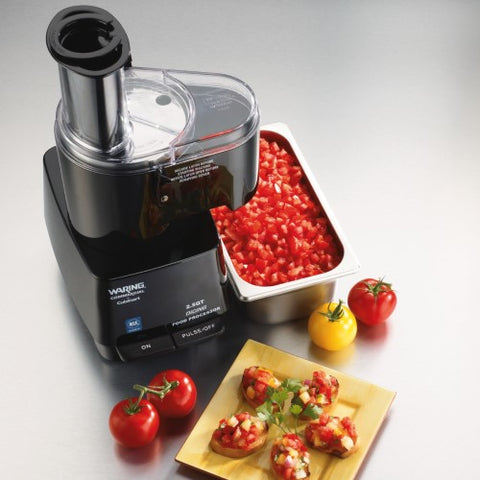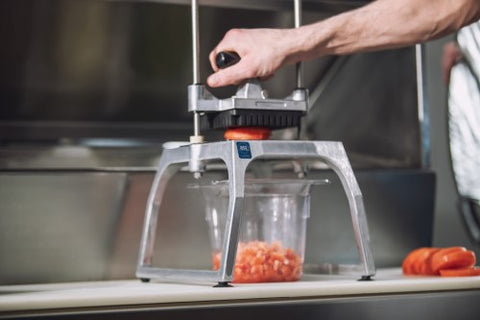Understanding the Difference Between a Food Processor, Food Chopper, and Food Blender

When you don’t want to spend 10 minutes peeling and slicing one ingredient with a knife, you have three basic options for prepping your food: a food processor, food chopper, or food blender.
There might not be one singular choice for your commercial kitchen. You might need all three, depending on your menu and what kind of prep is necessary.
Check out the rest of this guide to learn the similarities and differences between a food chopper vs food processor vs blender.
What is a food processor?
Commercial food processors are electrical appliances that cut food and ingredients with different types of spinning blades. Most food processors have a separate chute to add ingredients to prevent fingers from coming into contact with the sharp blades. Multiple types of blades perform a variety of tasks.
What does a food processor do? Complete laborious tasks like chopping herbs, slicing peppers, or emulsifying a sauce. You might be wondering, is a food processor the same as a blender? While food processors provide ample power and speed, they do not offer precision. Do not expect identical pieces or slices.
What is a food processor used for? Depending on your job’s size and complexity, you will want one of these different types of food processors.
- Batch Bowl Processor — A batch bowl processor has a blade that spins within a bowl or container. Once the container is full, the processor stops, and you must empty the batch before using it again. These compact options are more common in homes and modest commercial kitchens.
- Continuous Feed Processor — These processors can run continuously as processed food or sauce empties through a chute into a container of your choice. For larger batches in kitchens with a high volume of orders, a continuous feed processor is the way to go.
- Combination Processor — These processors combine multiple functions into one unit to save tablespace in your kitchen. For example, our Robot Coupe R2U Commercial Food Processor includes a batch bowl cutter setting and a vegetable prep setting that utilizes a continuous feed setup with an attached chute.
What is a Food Blender?
Food blenders are most similar to food processors, as both are electric food prep tools fitted with blades to prep food and drinks. However, as the name suggests, a food blender is intended to liquify, or pureé, whatever is inside. It cannot make cuts to dry ingredients and is best for making drinks like smoothies or sauces from softer ingredients.
The blade assembly in a food blender is typically at the base of a tall container resembling a pitcher. The spinning blades can blend veggies, fruits, nuts, herbs, and liquids. Commercial blenders withstand rigorous daily use in restaurants, bars, cafes, coffeehouses, and other foodservice operations.
In addition to a standard food blender that includes a jar or container, your kitchen may benefit from an immersion blender. Immersion blenders are handheld blenders that blend food while immersed in a stock pot, saucepan, or mixing bowl. These tools make whisking, mixing, and whipping a snap. When working with a large batch of ingredients, immersion blenders eliminate the step of transferring ingredients from a mixing jar or container.
What is the Difference Between a Food Processor and a Blender?
The biggest question now is... what is the difference between a food processor and blender? While food processors are designed to prep dry ingredients, blenders are designed to combine wet & dry ingredients.
The main factor to consider when choosing to use a food processor vs blender is the texture your food prep requires. If your desired result is more of a drink, a blender might be a better choice. But is a food processor the same as a blender? While they can perform a lot of the same tasks, a food processor has more prescision and control with maintaining your food prep texture.
What is a Food Chopper?
Food chopper is a broad term for dicers, slicers, and choppers that typically don’t include motorized components. Food choppers allow a chef to chop or slice a single item by pushing or pulling a handle to pass the food through sharp blades. This is the biggest difference between food processor vs chopper.
Food choppers grant ultimate control over the cut’s size and shape, which is helpful for many recipes. Whether you’re crafting a tantalizing salad or prepping onions and mushrooms for your standard delivery pizza, food choppers are the go-to kitchen tool for consistency and control.
Vegetable choppers, fruit choppers, and other choppers are heavy-duty pieces of kitchen equipment that are easy to clean and streamline preparation for many signature dishes. While many choppers are essential for foodservice businesses, most home kitchens only need something like a Nemco Easy Chopper to shave time off meal prep.
We stock several types of food choppers at Chefs’ Toys, including:
- Fruit and Vegetable Cutters — Cutters for fruits and vegetables are mainstays in commercial kitchens. These units typically contain a manual press for slicing veggies, cubing fruit, or wedging lemons.
- Tomato Slicers — Expect uniform tomato slices whenever you add one of these tools to your prep table.
- French Fry Cutters — French Fry Cutters are efficient and reduce the manual labor needed to serve top menu items at fast food and casual restaurants.
- Spiral Turning Slicers — Turning Slicers transform produce into long thin strands and are great for salads, soups, and garnish. Make zucchini noodles and other unique cuts with this tool, also called a spiralizer.
- Meat Chopper Grinders — Make gourmet burgers, delicious sausages, and stews with commercial meat choppers and grinders.
Food Processor vs. Food Chopper vs. Food Blender
So, which tool is the ultimate powerhouse in your commercial kitchen? Your choice will depend on what types of dishes you serve and the capacity you require. Our resident chefs and sales team thoroughly vet all of the appliances sold at Chefs’ Toys, so your final choice will come down to functionality, size, and capacity.
Of course, each appliance type has its distinct strengths. You may ultimately invest in more than one tool to provide your staff with the tools they need to prepare any item on your menu. For quick reference, here’s what types of foods and drinks you should make with each piece of equipment.
- Food Processor — When you need to shred, slice, or emulsify solid foods and don’t care about the precision of the cut, turn to a food processor. Food processors are terrific for grating vegetables, mixing bread dough, and blending dressings and hummus.
- Food Chopper — Food choppers deliver specific cuts when you need control over your food’s final proportions and shape. Food choppers are best for prepping produce, wedging lemons, slicing fries, and coring pineapples.
- Food Blender — Food blenders cannot perform cuts on solid foods, so save these appliances when your ingredients are either liquid or contain mostly water. Food blenders are ideal for smoothies, soups, and sauces like pesto.
Buying the Best Food Processors, Blenders, and Choppers
When you’ve decided what appliances are necessary for your commercial kitchen, shop with confidence at Chefs’ Toys. Each piece of equipment we offer online and on our sales floor has been tested and used by one of our foodservice experts so you can expect top-tier performance long after your purchase.
Ask the pros at Chefs’ Toys which food processor, food chopper, or food blender would best elevate your food prep.























